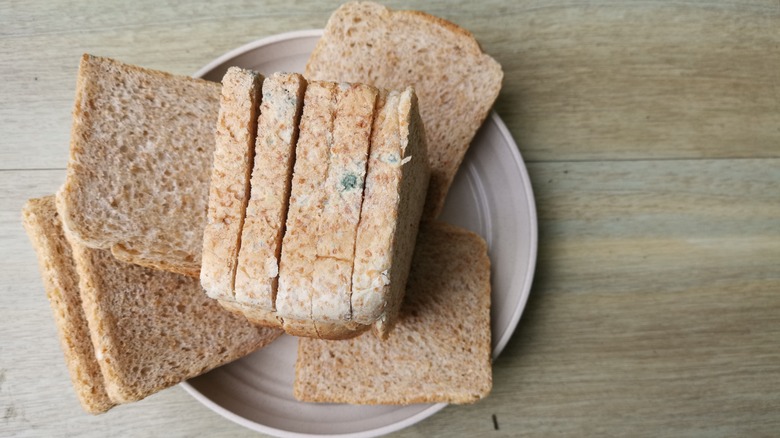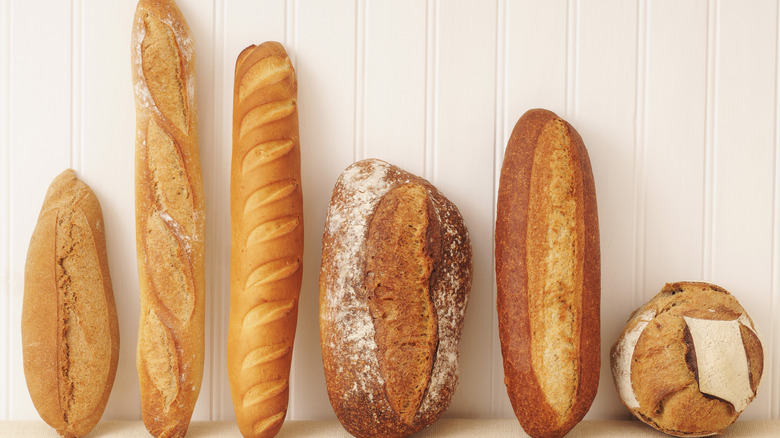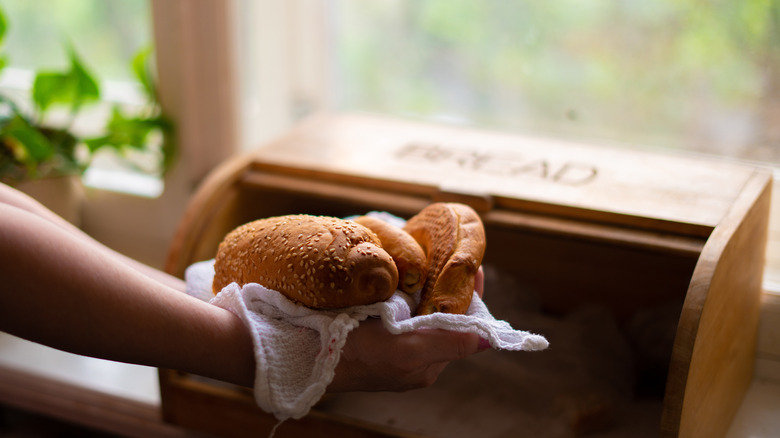Can You Eat A Loaf Of Bread If Only One Slice Is Moldy?
As the age-old adage goes, "one bad apple spoils the whole barrel." But does the same hold true for a single moldy slice in a loaf of bread? Unfortunately, the U.S. Department of Agriculture Food Safety and Inspection Service (FSIS) thinks so.
The FSIS recommends you toss bread and other baked goods as soon as you see mold, which may appear as discolored green, black, grey, brown, white, or yellow patches. The reason you can't just toss the affected slice and eat the rest of the loaf is because spores (microscopic reproductive cells that travel through the air to spread mold) may have already contaminated the bread beyond the visibly moldy zones.
Mold is actually a kind of microscopic fungus that lives on organic matter. To spread, it extends delicate roots resembling thin threads. These tiny roots can penetrate deeply into foods, especially porous ones like bread.
If you accidentally eat mold, it's not likely to seriously harm you. But with tens of thousands of types of mold out there, it's not possible to know for sure which one is dangerous, and harmful molds can induce allergic reactions and respiratory issues, according to FSIS. And, according to a 2007 study published in the Asia Pacific Journal of Clinical Nutrition, occasionally consuming small amounts of mold may not pose significant risks, but larger doses or prolonged exposure can lead to health concerns like chronic vomiting, diarrhea, or liver disease. So, it's best to be safe and just toss out your bread when mold appears.
How long does bread stay mold-free?
How long a loaf of bread can stay fresh and mold-free largely depends on moisture levels and the temperature in its environment. Mold requires water and warm temperatures (above 70 degrees Fahrenheit) to grow, so breads with higher water content (such as French loaves) that are stored in warm places are more likely to get moldy quicker. Breads that are very low in moisture, like dense rye and seeded breads, boast extended shelf-lives because they lack the water content that mold needs to thrive.
Thanks to the power of preservatives, most store-bought loaves maintain freshness for five to seven days at room temperature. In contrast, home-baked breads typically only last for three to five days in the same conditions.
Certain types of acid in bread also impacts its susceptibility to molding. Sourdough contains lactic acid bacteria, which stalls the process. The bread's acidity also makes for an unfriendly environment for mold, deterring its growth and ability to spread.
How to keep your bread fresher for longer
The way you store your bread also plays a role in keeping it free of mold. If you intend to consume it promptly, keep your bread at room temperature in a cool, dark, dry spot like a pantry, breadbox, or cabinet. Also, ensure that the bread is stored in dry, airtight packaging that doesn't trap moisture, such as plastic wrapping or a brown paper bag.
As a general rule, most loaves of bread will keep an extra three to five days longer if you store them in a refrigerator. It's worth noting, however, that refrigeration, while extending shelf-life, may turn bread stale faster.
But, you don't necessarily need to toss stale bread if you can't see any signs of molding. Staleness is not dangerous and is just the result of moisture loss and the recrystallization of starch molecules in bread over time, which causes hardening and impaired flavor.
Freeze your bread in an airtight zip-top plastic bag if you won't finish it in time. You can freeze lighter breads, like white hamburger buns, for up to three months. Denser breads with a higher fat content can be thawed and enjoyed up to six months after freezing, as fats act as a natural preservative.
If you're not sure how long your bread will last, try out the FSIS's app, The FoodKeeper. Search for your food item for tips on how to keep it mold-free for longer.



